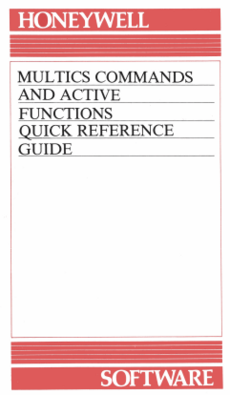Multics facts for kids
 |
|

Login screen for the ban.ai public Multics server.
|
|
| Company / developer | MIT, GE, Bell Labs |
|---|---|
| Programmed in | PL/I, Assembly language |
| Working state | Mature, historic, emulator available |
| Source model | Open source |
| Initial release | 1969 |
| Latest stable release | 12.7 / July 28, 2021 |
| Available language(s) | English |
| Supported platforms | GE-645 mainframes, Honeywell 6180 series machines |
| Kernel type | Monolithic kernel |
| Influenced | Unix, GEORGE 3, ICL VME, PRIMOS, Domain/OS, Stratus VOS |
| Default user interface | Command-line interface |
| License | Originally proprietary, Free software Multics License since 2007 |
Multics ("MULTiplexed Information and Computing Service") was an important early operating system. It was designed to let many people use a computer at the same time. This idea is called time-sharing. Multics also used a special way of handling computer memory, called a single-level store. Experts say Multics has influenced almost all modern operating systems. This includes everything from small computers to large mainframes.
Work on Multics began in 1964 in Cambridge, Massachusetts. It was a team effort. The main groups involved were MIT, General Electric (GE), and Bell Labs. They built Multics for a special computer called the GE 645. The first one arrived at MIT in 1967. Bell Labs left the project in 1969. GE then sold its computer business to Honeywell in 1970. Honeywell later sold Multics to customers, but it was not a huge success.
Multics had many features to make sure it was always working. It was meant to be like a public service, similar to how we get electricity or phone service. Its parts could be added or removed while it was running. This meant the system could grow by adding more computing power, memory, or storage. Multics also had special ways to control who could see or use files. This allowed for sharing information while keeping other data private.
Even though Multics had some problems, its new ideas greatly influenced computer science. Its biggest impact was inspiring the creation of Unix. Unix took many ideas from Multics but could run on smaller, cheaper computers. Unix was developed at Bell Labs. This allowed their team to continue their research on smaller machines.
Contents
Cool New Ideas in Multics
Multics introduced many new ideas that are common in computers today. One big idea was the single-level store. This meant the computer treated files and memory in a similar way. When you used a file, it was like it was already in the computer's memory. The operating system made sure any changes were saved to the disk. This was different from other systems where files and memory were kept separate.
Another important idea was dynamic linking. This allowed a running program to connect to other programs or tools as needed. It meant that programs could always use the newest versions of these tools. This also made it easier for different programs to work together. For example, a program could ask another program (called a daemon) to do something. It would simply make a normal call, and the daemon would handle the request.
Multics was also very good at changing its parts while running. You could add or remove central processing units (CPUs), memory, or disk drives. The system would keep working without shutting down. This was a huge deal for keeping the system available. Multics was also one of the first systems to use multiple CPUs at once.
Multics was designed to be very secure from the start. It was one of the first major operating systems with security built-in. It used a special system called "rings" to protect different parts of the computer. This helped make sure that only authorized programs could access important data. Later versions of Multics became very secure.
Multics was also the first operating system to have a hierarchical file system. This means files and folders are organized like a tree, which is how most computers work today. File names could be long and flexible. It was also the first to use separate stacks for each program in the kernel. The kernel is the main part of the operating system. Multics was also one of the first systems written in a high-level programming language, called PL/I.
In 1975, a person named Morrie Gasser created a program for Multics. This program made easy-to-say random passwords. It helped make passwords stronger and harder to guess. This was important for keeping classified information safe.
How Multics Developed
Multics was first made for the GE-645 mainframe computer. This was a large, powerful computer. In 1970, Honeywell took over GE's computer business. Around 1973, Multics was updated to run on the Honeywell 6180 machines. These new machines had better security features.
Bell Labs left the Multics project in 1969. Some of their team members then went on to create the Unix system. Multics development continued at MIT and General Electric. Honeywell kept working on Multics until 1985. About 80 Multics systems were installed around the world. They were used in universities, businesses, and government offices.
In 1985, Multics received a special security certification. It was the first operating system to reach this high level of security. From 1975 to 2000, Multics was sold by Groupe Bull. In 2006, Bull SAS released the source code for Multics. This made it free software, meaning people could use and change it.
The last Multics system running on original Honeywell hardware was shut down in Canada on October 30, 2000.
Multics Today
In 2006, the final version of Multics (MR12.5) was released as free software. This means most of its code is now available for anyone to use.
In 2014, people successfully ran Multics on modern computers. They used a special program called an emulator. This emulator lets new computers act like the old Honeywell machines. This means you can still experience Multics today!
Common Multics Commands
Multics had many commands that users typed to make the computer do things. Here are some examples of programs and commands used in Multics:
How Multics Influenced Other Systems
Multics and Unix
Multics greatly influenced the design of the Unix operating system. Unix was created by two programmers who had worked on Multics, Ken Thompson and Dennis Ritchie. You can see Multics' influence in many parts of Unix. This includes how files are organized and how commands are used.
However, Unix was designed to be much smaller and simpler. It aimed to fix some of the problems Multics had, like needing a lot of computer resources. The name Unix itself is a play on Multics. The "U" in Unix might stand for "uniplexed," meaning simpler, compared to "multiplexed" in Multics. This showed the Unix creators wanted a more straightforward system.
Ken Thompson, one of the Unix creators, once said Multics was "overdesigned." But he also said he liked its file system and the idea of a "shell." A shell is a program that lets you type commands to control the computer.
Influence on Other Operating Systems
Multics also influenced other operating systems. For example, the PRIMOS operating system was sometimes called "Multics in a shoebox." This meant it had many of Multics' ideas but in a smaller package.
The Stratus VOS operating system was also heavily influenced by Multics. It copied many of Multics' ideas for reliability and security. Stratus VOS is still used today in systems that need to be very reliable.
The security features of Multics were also used in ICL's VME operating system. The Edinburgh Multiple Access System (EMAS) also used Multics' idea of treating files and memory in a similar way.
See also
 In Spanish: Multics para niños
In Spanish: Multics para niños
- Time-sharing system evolution
- Peter J. Denning
- Jack B. Dennis
- Robert Fano – director of Project MAC at MIT (1963–1968)
- Robert M. Graham (computer scientist)
- J. C. R. Licklider – director of Project MAC at MIT (1968–1971)
- Peter G. Neumann
- Elliott Organick
- Louis Pouzin – introduced the term shell for the command language used in Multics
- Jerome H. Saltzer
- Roger R. Schell
- Glenda Schroeder – implemented the first command line user interface shell and proposed the first email system with Pouzin and Crisman
- Victor A. Vyssotsky


